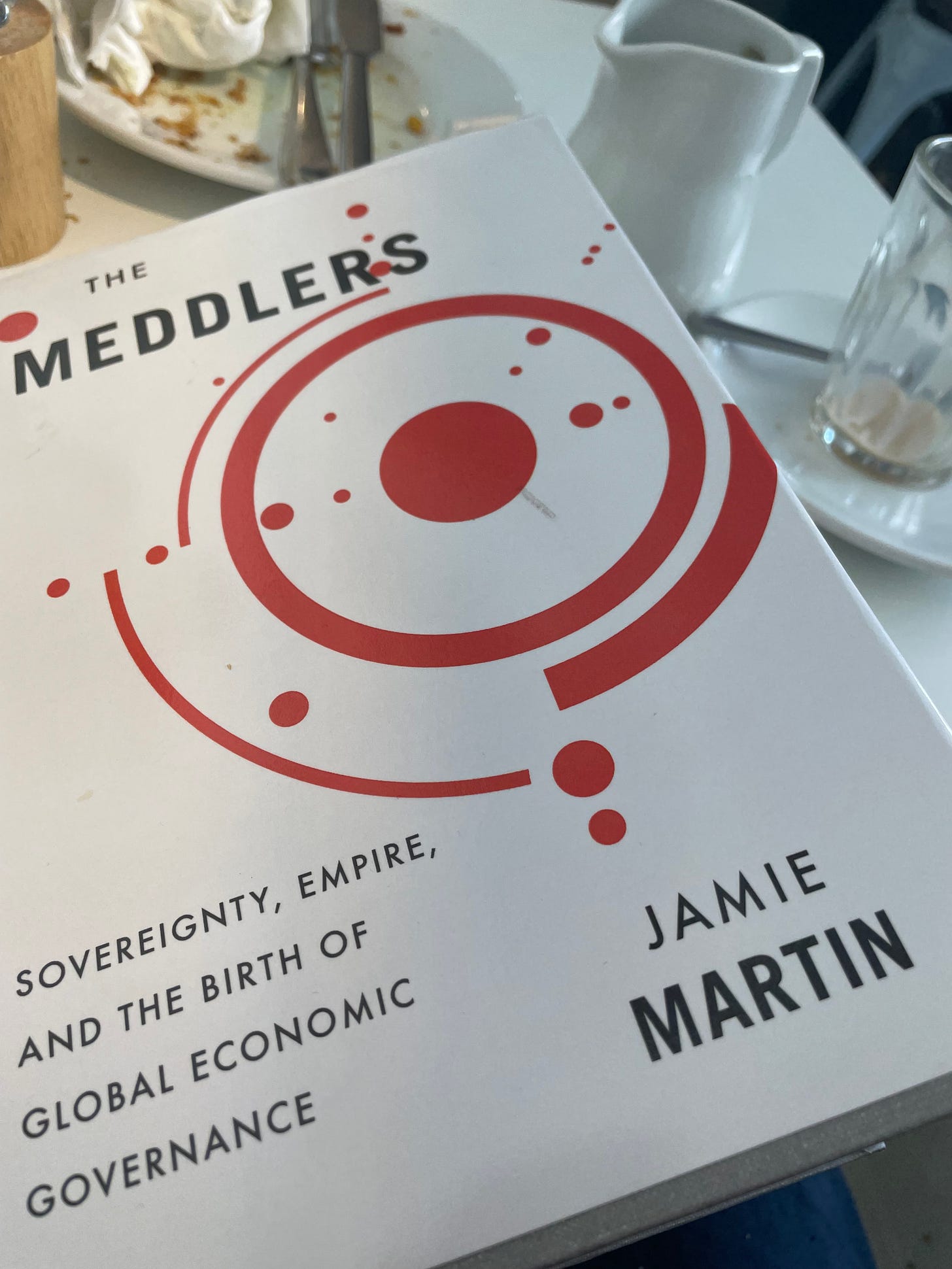The race is on to transform the fossil-fuelled climate system. To do that, society must restrain the debt-fueled Money System. Both envelop, and threaten to overwhelm the planet.
But to transform, we must first understand both as global systems.
The deaths and devastation of a whole town and its people - Lahaina on the Hawaiian island of Maiu - was yet another example of extreme, instantly devastating weather becoming more frequent. After an exceptionally dry summer Lahaina was wiped out by a passing hurricane that ignited ferocious wildfires across the island. Much of southern Europe was similarly scorched, threatening not only destruction, but also the future of the region’s food security.
And while here in Britain summer has been wet, chilly and grey - thanks only to Britain’s positioning on the northern side of the Jet Stream - we are vulnerable to Southern Europe’s wildfires as crops fail or burn. Spain supplies around a quarter of the UK's fresh produce imports, as well as 32 per cent of all the vegetables and 20 per cent of all the fruit sold in the UK.

On one of the hottest days back in June, I took my daily constitutional around the ripening, biscuit-coloured barley fields that surround our town. On the way I was stopped by a neighbour. “This hot weather is not unusual” she offered up defensively, “I am the daughter of a farmer and Suffolk has always had hot dry summers” implying that worry about climate breakdown is exaggerated.
This refusal of some to understand short-term weather patterns within the context of long-term climate change is frustrating and depressing. Friends and neighbours appear to have a blind spot for the bigger, systemic and more alarming picture. Yes, we have always had dry summers in this part of the British isles; but we also have always had millions of insects, birds and butterflies. Sadly, no longer.
The Meddlers by Jamie Martin
I’ve just finished The Meddlers - a lengthy text on the development of globalisation after the horrors of World War 1, when economic orthodoxy demanded austerity of starving war-torn Europeans, and set the scene for the rise of fascism.
Cheerful stuff it ain’t.
Reading The Meddlers has made my forthcoming book feel even more necessary. The author approaches the growth of international institutions of governance, including the League of Nations, through the lens of international diplomacy, while ignoring the role of Wall St. in those developments.
We know that a significant number of US President Wilson’s advisers during that era were Wall St. figures that had amassed fortunes both before and during that ghastly war. Alongside the American president, they went on to influence and shape the new norms of international governance and non-cooperation, ensuring global financial markets were in the driving seat.
One such figure was Bernard Mannes Baruch, a financier and statesman, who according to Wikipedia
After amassing a fortune on the New York Stock Exchange… impressed President Woodrow Wilson by managing the nation's economic mobilization in World War I as chairman of the War Industries Board.
He advised Wilson during the Paris Peace Conference. He made another fortune in the postwar bull market, but foresaw the Wall Street crash and sold out well in advance.
So there is a gap in Jamie Martin’s excellent history that waits to be filled…
Bonds and the Money System
It is equally frustrating to read excellent journalism weakened by a blinkered approach to the planetary-wide money system. Some writers have an eye for the localised detail and key individual players active in The Money System - in other words the financial elite defined as The Money Interest.
Yet those same writers appear to have a blind spot for The Money System - within which bond holders, bond issuers, asset managers, speculators and central bankers operate, and in which bonds are issued, marketed and paid or defaulted on.
That’s not unlike the blinkered approach to today’s planetary climate.
A striking example appeared in a weekend Financial Times magazine. Robin Wigglesworth wrote an illuminating and beautifully illustrated essay on bonds. He subtitled it: “A very short, very wild history of the biggest untamed force in global finance” - with the headline: How bonds ate the entire financial system.
Stories of bonds are indeed fascinating. A Dutch bond dated 1648 and still paying interest to a creditor, tells a revealing tale of commercial life in Amsterdam in 1648.
My favourite bond story appears in William Makepeace Thackeray’s 1847 novel Vanity Fair - a novel I devoured eagerly as a young girl. Becky Sharp is the appropriately named heroine and the story, in brief, is about her “sinful attachment to worldly things.” Becky is a strong-willed, cunning, moneyless young woman determined to make her way in society. She envies her richer friends and the regular income they enjoy from government bonds (debt) known then as Consols - the name of debt issues that took the form of perpetual bonds and were first issued by the the Bank of England in 1751.
Thackeray has Vicky exclaim:
Heigho! I wish I could exchange my position in society and all my relations for a snug sum in the Three Per Cent. Consols”, for so it was that Becky felt the Vanity of human affairs, and it was in those securities that she would have like to cast anchor. 1 (My emphasis)

Many today would not only like to “cast anchor” in 3% government bonds but to go further, and use the bonds as collateral to raise a ship of gold.
But the real fascination with bonds lies in a history and evolution that mirrors, and is shaped by the history and evolution of the international financial system. Wigglesworth does not go there. While I assume the reason was editorial limits on word length, nevertheless it seems to point to a blind spot.
Bonds and Inflation
Wigglesworth helpfully explains the difference between loans and bonds to creditors and debtors. Loans have interest rates that usually fluctuate - often pegged to
a central bank’s interest rate or some other pre-agreed benchmark.”
Bonds in contrast, “almost always pay a rate that never changes over its lifespan. That’s why “fixed income” is often used as a synonym.
However, and it is a big however. The value of revenues from bonds can vary, depending on the rate of inflation.
Bond holders, like all creditors, loathe inflation, because inflation eats away at the value of the revenues (interest and principal) generated by bonds.
Debtors by contrast, far more numerous than creditors, benefit from inflation. That is because inflation erodes the value and cost of debt.
Creditors are a powerful group and because of their loathing of inflation economists, central bankers and policy-makers advocate deflationary economic policies, including high, real central bank rates, austerity and pay freezes. Most economies are geared to serve the interests of creditors - the 1% - rather than the interests of the millions of indebted, risk-taking and productive entrepreneurs, farmers and home-buyers.
[On a more arcane, but important social justice point: the inflation index (the Retail Price Index, RPI) used for gilts (and railway fares) is different - and often higher - than that used for hiking railway workers wages (the CPI, Consumer Price Index).
I wrote about a recent political and “statistical gunfight” over these indices in the Independent back in August, 2018.)
The history of bond issuance
Wigglesworth tells us that the issuance of bonds (debts) began in the merchant city of Venice way back in 1171. They were a handy (and forceful) way for the Venetian ruler to raise money from citizens. Perpetual bonds (i.e. bonds that promised permanent interest payments to the lender) were also an attempt to dodge the Catholic Church’s edicts against usury.
And so the brilliantly written Wigglesworth story goes. Almost every one of his bond stories is linked to an individual or individuals: The Doge of Venice. Michael Milken of the investment bank Drexel Burnham Lambert - and inventor of a whole new class of bonds, ‘junk bonds’. [Milken pleaded guilty to six counts of securities and tax violations, paid $600mn in fines and spent 22 months in jail. He was pardoned by Trump in 2020.]
Before Milken, corporations raised loans. After Milken they raised bonds.
Then there’s Lewis Ranieri of Salomon bank - who invented the “tranching” of mortgage-backed bonds or securities. Ranieri packaged up individual mortgages (loans) into bonds and then traded chunks of those bonds - a process known as securitisation.
Wigglesworth then marks out Sigmund Warburg - who at a time of “restrictive American legislation” - ie capital controls - invented a way of circumventing the international regulation of capital flows that had been introduced under the Bretton Woods System.
Only Wigglesworth does not describe Warburg’s invention as circumvention.
Instead it becomes a story of ‘financial innovation’ by a brainy outsider. A merchant banker who loved 19th century literature and was “said to hire people purely on the back of a shared love for Anthony Trollope, TS Eliot, Charles Dickens and Thomas Mann”. (But interestingly, not Thackeray.)
Its an insightful work of journalism…. and yet another motivation for a book on how actors on Wall St., the City of London and Zurich always operate within a system.
And how in the 1960s Warburg helped circumvent the Bretton Woods monetary system’s regulations and began thereby to transform the international Money System of that time.
A book on how it can be transformed again: to serve the interests of societies across the world.
W.M. Thackeray, Vanity Fair, quoted on p. 51 of Martin Slater’s The National Debt






I love the way Ann Pettifor unpacks complex topics and gives the historical and critical analytical context that so many commentators lack. I highly recommend her writings...
History reveals very clearly that whatever the money system, preventing increases in the prices of land, natural resources, commodities, foodstuffs, capital goods or services requires other system reforms. Nature has a zero cost of production and, therefore, nature should not have a selling price. Rather, as David Ricardo explained and Henry George confirmed, every parcel or tract of land has a potential rental value based on output given the same input of labor and capital goods. All that needs to be done to cut inflation to zero is to capture the full potential rental value of nature (i.e., of surface land, natural resource-laden land, the seas, other natural assets such as frequencies on the broadcast spectrum or takeoff and landing slots at airports, and competition-limiting licenses issued by government) to pay for needed and desired public goods and services. Economics professor Fred Foldvary some years ago estimated that "rents" comprised almost one-third of global GDP.
Henry George made a strong case for the elimination of all taxation except for that of rents. He argued against the taxation of income. I would modify his proposal to take into account the long history of under-taxation of rents that has led to today's ever-worsening concentration of income and asset ownership at the top. This could be addressed by an individual income tax that simplified compliance but was very progressive. How might this look? Exempt all individual incomes up to some amount (e.g., the national median income). Eliminate all other exemptions and deductions. Above the exempt level, impose in increasing rate of taxation on higher rates of income. The effect will be to lift the burden of taxation from income earned producing goods and services, shifting the weight of taxation to gains from speculation and from rent-seeking privileges enjoyed by those at the top.